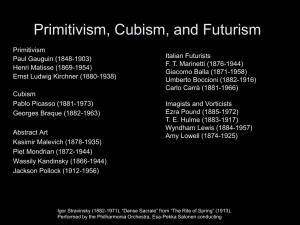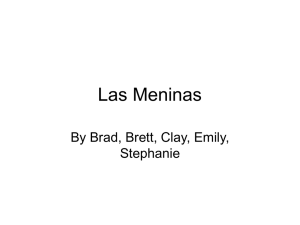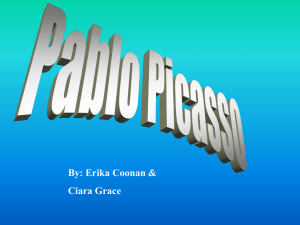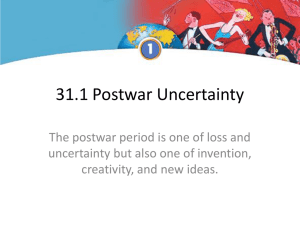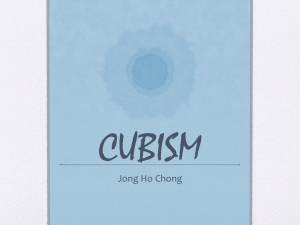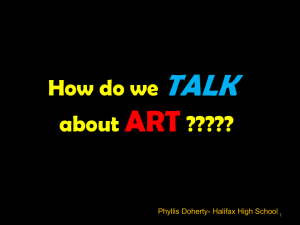Cubism Period
advertisement
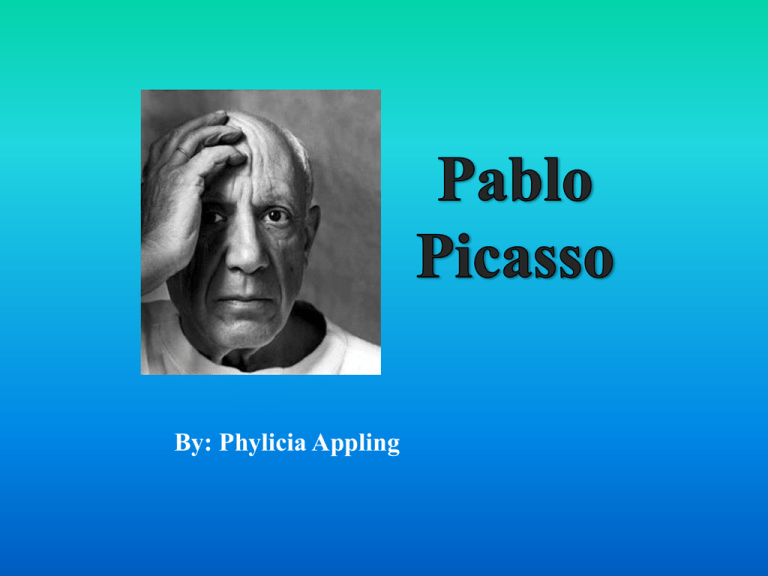
By: Phylicia Appling Name: Pablo Picasso Born: October 25 1881, Malaga, Spain Died: April 8 1973, Mougins, France Father: José Ruiz Blasco (1838 - 1913) Mother: Maria Picasso Y Lopez (1855 - 1939) Early Years • Pablo Picasso started to paint when he was eight years old. • From the age of five on, Pablo would get drawing lessons at school, in Malaga. • As Picasso's father was an art teacher, he would take full control of Pablo's education in art. • As such, Picasso's father was ubiquitous in Pablo's life, both at home and in school. Family • Pablo Picasso's father, Don José, descended from an old, wealthy family from the province Léon (North-West of Spain). • His mother, Doña Maria was from Andalusia and of Arabic descent. • Pablo had two younger sisters: Dolorès, or Lola (1884 - 1958) and Concepción (1887 - 1891), called Conchita, who died at the age of four. • In 1895 his father was appointed at the art academy La Lonja in Barcelona. • Picasso's father rented him a studio in Barcelona. • With the financial aid of his uncles, Pablo went to study in Madrid at the end of 1897. • Because Madrid had nothing new to offer him, he decided to quit mid-1898. • In October 1900, at the age of 19, Pablo Picasso moved to Paris, in the company of Carlos Casagemas. • Remarkably, in his first two major paintings, The First Communion (1896) and Science and Charity (1897), Pablo includes the (rather uninspired) portrait of his father. • As an artist, Pablo's father specialized in painting animals, the least valued genre in his time. The most valued genres were history pieces, as well as portraitism. • In 1891 Picasso's father got a new job at the art school Instituto da Guarda in La Coruna, to where the family moved. • Pablo would begin to sign his artworks with Pablo Ruiz (after his father), but from 1900 on he would use his mother's last name: Picasso. • As the myth goes, Don José was so impressed with the ability of the young Pablo that in 1894 he gave his palette and brushes to Pablo and would never paint again. • Picasso's relationship with his parents became strained when he quit his studies. Picasso’s Period Styles Young Picasso (1881 – 1901) Rose Period (1904 - 1906) Blue Period (1901 - 1904) African Period (1906 - 1907) Cubism (1907 - 1915) Young Picasso Picasso's first painting at age 8, Picador (1889). The first communion 1896 Realistic Oil on canvas • The painting depicts Pablo Picasso's sister, Lola, at her first communion. • "The First Communion" was Picasso's entry into the official artistic world. He presented it at the Third Exhibition of Fine Arts and Artistic Industries in 1896. Blue Period • Pablo Picasso's Blue Period refers to a series of paintings in which the color blue dominates and which he painted between 1901 and 1904. • The blue period is a marvelous expression of poetic subtlety and personal melancholy and contributes to the transition of Picasso's style from classicism to abstract art. • Picasso was an accomplished classicist painter, but like many young artists of his time, he was dissatisfied with the dogmas of traditional art. • Pablo Picasso is generally associated with cubism and related styles which are predominantly abstract. It is therefore essential to realize that at the time of Picasso's blue period, abstract art as we know it today didn't yet exist. • Picasso and his contemporaries were experiencing the after-shock of an artistic eruption called Vincent Van Gogh, which hurdled an astonished art world into the 20th century and towards abstract art. The Color Blue • Some people believe that, by nature, man associates colors with emotions, the color blue being associated with melancholy. • In Christian iconography blue represents the divine and in a rather more secular sense it stands for the super-natural as well as the erotic. • Although Picasso's blue period melancholy was sincere, the people he painted have an element of pathos and melodrama. • When Picasso's close friend Carlos Casagemas commits suicide at the age of 19, Picasso's trauma finds expression in a series of deeply sentimental paintings which comprise his blue period. • Picasso's early days in Paris are characterized by poverty, which contributed to the melancholy of his blue period paintings, but it's certain that the sadness of his blue period paintings alienated potential buyers of his art work and thus, contributed to his poverty. • Death of Casagemas 1901 Oil on canvas • Impressionalism; Blue Period • Picasso spent most of his time in Barcelona, until he moved to Paris definitively. • Picasso blue period has an atmosphere of resignation and silent mourning. • Picasso's depression didn't end with the beginning of his rose period, which succeeded the blue period and in which the color pink dominates in many of his paintings. “Le Gourmet” 1901 Impressionalism; Blue Period “The Tragedy” 1903 Impressionalism; Blue Period “Couple in Café” 1903 “Girl in Chemise” 1905 Impressionalism; Blue Period The Rose Period • During his Rose Period, Pablo Picasso would, for the first time in his career, develop stylistic means that would become part of his Picasso Style, which made him the most important artist of the 20th century. • 1904 is a transitional year and belongs neither truly to the blue period, nor to the rose period. Rose Period • In 1905-06, Picasso's palette began to lighten considerably, bringing in a distinctive beige or "rose" tone. The subject matter also is less depressing. Here are the first appearances by the circus performers and clowns that will populate Picasso's paintings at various stages through the rest of his long career. Impressionalism; Rose Period: oil on canvas Acrobat with young harlequin 1905 Family of acrobats, with monkey 1905 • Pablo Picasso was a creature of the 19th century. Although he spent most of his life in the 20th century, his work and thinking would remain a product of 19th century romanticism. • Picasso explored how to combine expressionism with classicism, a process for which he laid the basis in his Rose Period. • A major commercial breakthrough for Picasso occurred when Clovis Savigot, a former circus clown who had started an art gallery in Paris, began to feature Picasso's work, possibly attracted by Picasso's paintings of circus artists. • Through Savigot's gallery, Picasso came in contact with Leo and Gertrude Stein, who would become important collectors of avant-garde art. The Acrobats 1905 Impressionalism; Rose Period: oil on canvas Circus Family (the tumblers) 1905 Impressionalism; Rose Period: oil on canvas Woman with crow 1904 Impressionalism; Rose Period: oil on canvas • From his Rose Period on, Picasso would continue to produce figurative art occasionally, but it would never again be his main style. Impressionalism; Rose Period: oil on canvas • From May 2004 until June 2006 the most expensive painting in the world was "Boy with pipe" (1905) $104,000,000. Boy with pipe 1905 African Period • Picasso's African Period, which lasted from 1906 to 1909, was the period when Pablo Picasso painted in a style which was strongly influenced by African sculpture. • This period, which followed his Blue Period and Rose Period, has also occasionally been called the Black Period. • In May or June 1907, Picasso experienced a "revelation" while viewing African art at the ethnographic museum at Palais du Trocadéro. African Period Head of a Woman, Figure, Standing Nude, Nude, Standing Man 1907 • Picasso's discovery of African art influenced the style of his painting Les Demoiselles d'Avignon. • Although Les Demoiselles is seen as the first Cubist work, Picasso continued to develop a style derived from African art before beginning the Analytic Cubism phase. • After painting Les Demoiselles d'Avignon, Picasso began painting in a style influenced by the two figures on the right side of the painting, which were based on African art.. Les Demoiselles d'Avignon 1907 Cubism; Cubism Period: oil on canvas Cubism Period • To understand where the term cubism comes from, we have to digress on the rivalry that existed between Picasso and Matisse. • Matisse had a huge following after painting Blue Nude which caused a scandal among the art world. • When Picasso produced his Demoiselles, many young artists that had previously followed Matisse, began to follow Picasso & his radical new style of painting. • One of the converts was Georges Braque. • When Braque submitted a series of paintings to the Salon (an annual Paris art show of contemporary French art), Matisse, was instrumental in the Salon's rejection of all of Braques' works. • When explaining, Matisse, made a drawing after one of Braque's landscapes, to show how they were made out of 'little cubes' and from there on "cubism" was a no-brainer. • With Les Demoiselles d'Avignon Picasso reached a level of abstraction that was a radical enough break with the classical dominance of content over form. A hierarchy is reversed in Les Demoiselles d'Avignon and the style which followed from it is Cubism. • It is important to fully realize the importance of cubism. It isn't just "Picasso's style" but marks the real beginning of abstract art. Cubism; Cubism Period: oil on canvas • Friendship 1907 • Queen Isabela 1908 Cubism; Cubism Period: oil on canvas “Landscape with two figures” 1908 Portrait of Ambroise Vollard 1910 Cubism; Cubism Period: oil on canvas Three Musicians 1921 Cubism; Cubism Period: oil on canvas War, Art & Guernica • By the late '30s, Picasso was the most famous artist in the world. He was called upon to depict the brutality of fascist aggression in the Spanish Civil War with his monumental "Guernica". • "Guernica", filling an entire wall, is surely the best-known 20th-century work of art. It relates to a specific historical event, and expresses Picasso's political commitment. For this reason, art and politics, the creative hallmarks of the work and its historical circumstances, must be treated as inseparable. • The horizontal-format composition uses seven figures, or figure groups; it is clearly yet subtly divided up. • Though it is readily taken in as a whole, "Guernica" is nonetheless a work of multi-layered complexity. • From the start on May 1st to the completion on June 4th , Picasso took just five weeks. • Many other paintings from this period reflect the horror of war. Guernica 1937 Cubism, oil on canvas Portrait of Jacqueline Roque with Flowers 1954 Cubism, oil on canvas Jacqueline in the Studio 1956 Cubism, oil on canvas Las Meninas •From 17 August to 30 December 1957, Picasso did a series of 58 very different largescale oils related to "Las Meninas", painted by the Spanish artist Diego Velazquez in 1656. •The Louvre invited him, shortly after the Second World War, to hang his own work alongside the original, for a single day, in order to establish the stature of his art through the comparison. Las Meninas 1957 Cubism, oil on canvas (influenced by Velazquez’s art) Picasso’s Late Works • In the last two decades of his long career, Picasso produced more work than at any other time of his life. During this period, some works are not only dated by month and day, but with a numeral (I, II, III, etc.) indicating multiple works created that single day! • This late period tends to be overlooked, but contains some of the finest of Picasso's paintings. • Some critics maintain Picasso was creatively lazy at this point, but a close look at the work is very rewarding. • He had achieved a level of effortless artistic expression that has still not been fully appreciated after more than 25 years. Cubism, oil on canvas Man Writing 1971 Man with guitar 1972 Self-Portrait 1972 Cubism, oil on canvas Regardless of your position on Picasso's personal & artistic life, each of us should, in view of our own mortality, be awed by his final self-portrait. • Throughout Picasso's lifetime, his work was exhibited on countless occasions. Most unusual, however, was the 1971 exhibition at the Louvre, in Paris, honoring him on his 90th birthday; until then, living artists had not been shown there. In 1980 a major retrospective showing of his work was held at the Museum of Modern Art in New York City. Picasso died in his villa Notre-Dame-de-Vie near Mougins on April 8, 1973 http://www.biography.com/p eople/pablo-picasso-9440021 Bibliography • Encyclopaedia Britannica, 1994 and Encarta 1999. • The Museum of Modern Art. Pablo Picasso, a retrospective. Ed. William Rubin, chronology by Jane Fluegel. New York. 1980. ISBN 0-87070519-9 • Mallen, Enrique. The Visual Grammar of Pablo Picasso. Berkeley Insights in Linguistics & Semiotics Series. Berlin: Peter Lang. 2003.



